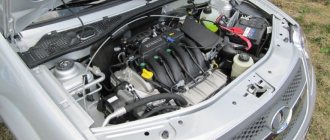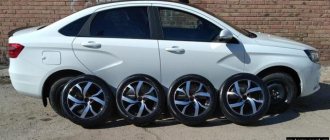A tire is not just rubber that softens the passage of uneven surfaces, but a functional design characterized by a complex structure. It ensures wheel traction on any road surface, effective braking and realizes the traction characteristics of the engine. Tires affect the vehicle's maneuverability, fuel consumption and the noise level created by the vehicle.
Wheel sizes of Lada Largus
The size of the wheels affects not only the appearance of the car, but also how it will behave on the road. AvtoVAZ indicates only one wheel size for the Lada Largus - 185/65 R15. Wheel parameters:
- 6Jx15;
- ET (departure) - 50;
- the distance between the holes for fasteners (bolt pattern) is 4x100.
Exactly the same size is indicated for Renault Logan, from which most of the components and parts for Largus were borrowed. In addition to this size, it is possible to install others:
- 185/70R14;
- 195/65R15;
- 205/55 R16;
- 205/50R17.
When choosing, keep in mind that the wheel size should not differ significantly from the standard one. Installing larger rims and tires may negatively affect the operation of the ABS and ESP systems, and their calibration will be disrupted.
Acceleration and traction characteristics are affected by the weight of the wheels - the lower this value, the faster the car will accelerate and the better it will hold the road.
The situation is different with the Lada Largus Cross in the back of a van. This model is equipped with wheels with a radius of R16 from the factory; all other parameters (offset, bolt pattern) are the same.
Options
The AvtoVAZ concern added the Cross prefix to the model name for a reason. It is understood that the model has increased off-road capabilities.
The parameters of the basic wheel rims are as follows:
- drilling parameter is 4×100;
- wheel width - 7.0 J;
- disc offset is ET 40;
- centering hole size - 60.1.
Knowing all the various methods for producing wheel rims and their advantages, you can choose a set of quality products for Lada Largus. In order for the disc to fit perfectly, you also need to know the basic parameters and dimensions of the mounts.
Selection of tires for Lada Largus
AvtoVAZ equips configurations above the base with Continental Premium Contact tires, but usually only for summer ones. For this reason, owners have a question about how to choose summer, winter or all-season tires for their car.
Selection of summer tires
Tires must match the wheel size. When choosing, the speed and weight index, brand and tread pattern are taken into account. The production date of the tires plays an important role - if they were made more than 5 years ago, it is better to refuse such a purchase.
Tread pattern
There are three types of patterns: asymmetrical, directional and symmetrical. The latter is the most popular, as it is considered universal and fits most cars. This is the best option for everyday driving around the city - without racing or off-road use. The main reason for choosing this design is its affordable price. Tires on Lada Largus with a symmetrical pattern are cheaper than all others. Such tires also have disadvantages - poor handling at high speed and wet asphalt, problems with sharp turns.
The directional tread pattern copes well with moderate off-road conditions and drains water well, showing normal handling and stability on wet road surfaces. The disadvantages include excessive noise, they cannot be placed on different sides due to strict direction, soft edges of the tread reduce directional stability.
The asymmetrical pattern shows the best characteristics: good directional stability, reduced risk of aquaplaning, you can swap wheels if necessary, increased controllability at high speed. The only drawback is the high price.
Profile height
If it is not possible to change the rims, it is recommended to install a standard tire size. Many owners strive to improve the appearance of their car. The most obvious way to do this is to install larger wheels, and this will require appropriate low-profile tires.
With a profile height of more than 60%, it is not advisable to use the car on the highway - such a tire is suitable for poor road surfaces and softens all unevenness. For driving on asphalt, it is better to use low-profile tires, as they improve dynamic performance and handling. But ride comfort is reduced - every bump will be reflected in the suspension.
Winter tires
When choosing winter tires, a lot depends on the budget, because there are European, Japanese, Chinese, and Russian brands on the market that produce tires in different price segments. For Lada Largus, it is recommended to use standard tires recommended by the manufacturer in winter. All that remains is to choose between studded and non-studded.
Handling when driving on snow is affected not by the presence of studs, but by the tread pattern. The pattern of studless rubber should contain many rectangular blocks arranged in a checkerboard pattern. The tread depth is also important - it should be at least 8 mm. The lamellas provide good grip on winter roads. Studless tires are often called “Velcro.” This is an ideal option for regions with mild winters, where ice and temperatures below 5 degrees are rather an exception. For wet snow, a tire with a directional tread pattern is suitable, as it drains water well. Advantages of studless tires:
- suitable for use on wet and dry road surfaces;
- does not make noise;
- does not have a negative impact on the road surface;
- It is resistant to high temperatures and does not impair controllability.
The main disadvantage of studless tires is their unsuitability for use on icy road surfaces. On ice and compacted snow you cannot do without tires with spikes.
The more studs on the tread surface, the better the grip on the winter road - slipping will be reduced, and the braking distance will be significantly reduced. But such tires also have their drawbacks:
- not suitable for wet snow;
- on dry or wet asphalt, the braking distance increases and the risk of skidding is higher;
- on loose snow they will not help the car to leave, but on the contrary, they will bury it even more;
- increased noise on asphalt;
- Fuel consumption increases slightly.
Despite a large number of shortcomings, it is the studded tires on the Lada Largus that have gained the greatest popularity in the middle zone and in the north, where weather conditions do not allow the use of other types of tires.
Selection of all-season tires
The niche of universal tires is occupied by all-season tires. For the most part, such tires are produced with an asymmetric tread pattern. The inner side has a rectangular pattern and is suitable for driving on snow, further increasing traction on icy roads. The outer side has a V-shaped tread, which allows you to effectively remove water from the contact patch between the tire and the road. "All-season" cars come in different types. The most popular are tires adapted for use on asphalt in the summer, but for winter roads this is not the best option. There is no point in considering off-road tires - they cannot be used on Largus, although they are considered universal for winter and summer.
On all-season tires you can find two abbreviations - All seasons or M+S (Mud+Snow - mud + snow). But these designations do not constitute official confirmation of the possibility of use in different conditions. The advantages of “all-season” tires include:
- savings - no need to buy a summer and winter set of tires, especially important if the car is not used year-round;
- the price is lower than that of specialized tires for a particular season;
- in mild winter conditions they show better performance than special kits.
This is where the advantages end; such wheels have many more disadvantages. Their main drawback is that they are equally functional in both summer and winter, losing out to seasonal products in many respects. Most of these tires are not recommended for driving at high speeds; their cross-country ability also suffers in different conditions.
All-season tires wear out quickly; buying a new set every two years is standard practice. Summer and winter sets can last 3-4 years, and with measured movement - even longer.
In harsh winters and icy conditions, driving on such wheels is unsafe and increases the risk of getting into an accident.
The influence of sizes on technical characteristics
Increasing disc diameter
The diameter affects the style of the car; increasing it improves road holding and steering accuracy, but comfort on problem roads will decrease.
Increasing width
When installing wider products, steering accuracy and road holding will improve, but fuel consumption will increase.
Increasing tire width
Increasing the width of the tires themselves will also have a positive effect on road holding, on the accuracy of car control, grip on dry roads will become better, and driving on uneven roads will become more comfortable. However, resistance to aquaplaning will deteriorate, noise will increase, fuel consumption will increase, and the tires will wear out more quickly.
Magnetto Wheels
The car is equipped with original 15-inch parts manufactured by Magnetto Wheels. On the Lada Largus the wheel parameters are 6×15/4×100 D60.1 ET50:
- width - 6 inches;
- center-to-center distance - 4x100;
- standard diameter 15 inches;
- diameter of the central hole - 60.1 mm;
- the offset is 50 mm.
According to car owners, products from Renault Logan 5.5×14/4×100 D60.1 ET43 are suitable, but 185\70R14 tires will be required.
Lada Cross
The factory-assembled 16-inch alloy wheels on the Largus Cross. They have unique parameters:
- width is 6 inches;
- drilling (distance between bolts) - 4x100;
- departure - ET50;
- CO - D60.1.
The stated size of Lada Cross parts corresponds to 205/65R16 tires. AvtoVAZ installs Continental Premium Contact tires with a low profile (55% of the width).
Replacing wheels on Lada Largus
There are many reasons why you have to remove one or more wheels. This is a simple puncture, replacing brake discs or pads, suspension repairs, changing tires. Every driver, regardless of length and experience, should be able to remove and install a disc on a hub. The procedure is simple and can be done with your own hands. To change a wheel on a Lada Largus you will need a standard set of tools:
- jack;
- wheel wrench, can be replaced with a wrench with a 17 mm head.
For safety reasons, work under a vehicle that is supported only by a jack is prohibited. It is advisable to play it safe and add bricks, timber spacers and other suitable devices.
Replacement process
Using a 17 mm socket, you need to unscrew the fastening bolt that secures the spare wheel in the niche. For factory decorative caps - installed on stamped discs - you will need a special key for removal; it is included in the standard tool kit. After removing the hubcap, you need to loosen the wheel bolts using a wheelbrace. Next, the car is jacked up, the wheel bolts are completely unscrewed, and the disc is removed. Installing a new wheel is carried out in the reverse order. Forged and alloy wheels use different bolts.
Safety
The procedure for replacing wheels is not a complex operation, but even here you will need to follow basic safety rules. The vehicle must be on level ground and a hard surface. Wheel chocks must be installed under the wheels, and the machine is additionally secured with a hand brake. In addition to the jack, safety stops should be used - factory products are a priority.
DIY tire replacement rules
In order to save money, many car enthusiasts are thinking about replacing tires themselves. The process is not the easiest, but doable. To work, you will need a balloon, mounting blades, a jack and a compressor or pump. When performing the procedure, you should take into account some tricks, without which this event is doomed to failure.
Removing the tire from the rim
First you need to remove the wheel from the hub. Then it is laid on the ground so that the nipple nipple is at the top. All the air is released from the tube or tire, in the case of a tubeless tire, and the nipple nipple is recessed inside. You need to stand on the wheel with your feet so that the edge of the tire separates from the rim of the disc. Sometimes extra force may be required if the rubber sticks to the metal.
A mounting blade is inserted into the gap between the edge of the tire and the disk, then a second one. The main task is to turn the sidewall of the tire beyond the edge of the rim. If the wheel has a tube, it is pulled out through the resulting gap. If the tire is tubeless, you need to unscrew the entire side of the tire by the rim, then unscrew the second sidewall of the tire using the same edge of the rim and remove it from the rim.
When working, you must apply considerable force and be careful not to damage the disc. Cast products made from light alloy materials are especially fragile.
Mounting a tire on a rim
Before installation, make sure that the tire is the correct size and has no defects. It is recommended to remove the balancing weights and the old nipple. When installing, you should take into account the markings on the tire, usually the direction of travel in the form of arrows.
To facilitate the installation task, you can apply a soap solution to the edge of the tire and the rim of the disk, but within reasonable limits, otherwise the tire will slip. Installation is carried out in the reverse order of removal. First, one edge of the tire is put on, after which the second one is wound on the rim.











